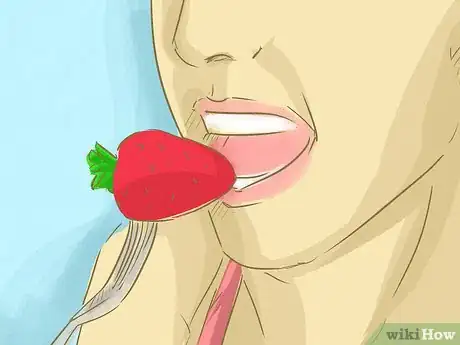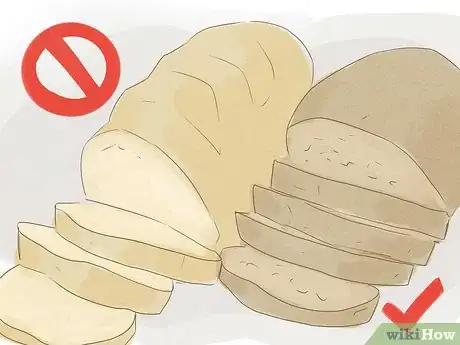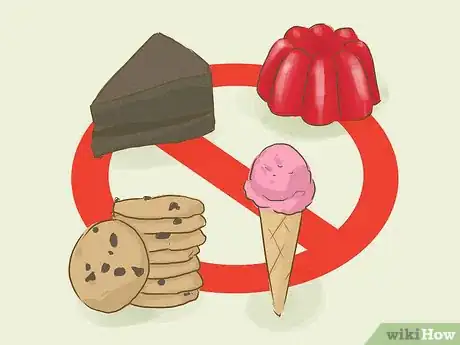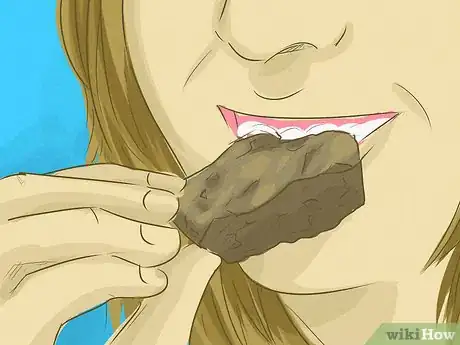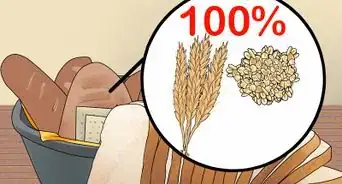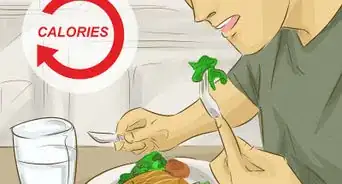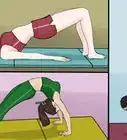This article was co-authored by Claudia Carberry, RD, MS. Claudia Carberry is a Registered Dietitian specializing in kidney transplants and counseling patients for weight loss at the University of Arkansas for Medical Sciences. She is a member of the Arkansas Academy of Nutrition and Dietetics. Claudia received her MS in Nutrition from the University of Tennessee Knoxville in 2010.
There are 18 references cited in this article, which can be found at the bottom of the page.
This article has been viewed 19,413 times.
Eating carbs while still losing weight is easy – in fact, it’s the best way to lose weight. Carbs give you energy that you’ll need to power your workouts and get through your day. Losing weight simply requires that you cut back on the volume of carbs (as well as the volume of fats and proteins) that you’ve been consuming. Avoid sugars and refined grains. Instead, incorporate lots of fresh fruits, vegetables, legumes, and whole grains.
Steps
Finding a Diet That Works
-
1Reduce your caloric intake. If you’re an average person, your insulin sensitivity is probably quite good, and you don’t need to make specific cuts to your carbohydrate intake over any other types of calories like fats. People gain weight when the calories they consume exceed the calories they need to maintain their physical functions.
For instance, if you burn 1,500 calories daily, but consume 2,000 calories daily, you will gain weight. To reduce your caloric intake, you should reduce the amount of carbs, protein, and fats you take in without totally eliminating any one macronutrient.[1]- For instance, instead of drinking soda, drink water.
- Instead of eating a sandwich, try a wrap.
- Instead of eating a big bowl of pasta, eat a small bowl of pasta.
- Cut back on the total amount of calories you consume by incorporating low-calorie meals into your diet, such as salads.
- Typically, a diet that permits about 50 to 100 grams of carbs per day is ideal for people trying to lose weight while still consuming some carbs.[2]
-
2Cut back on carbs without cutting them out entirely. People with poor insulin sensitivity will benefit from making specific cuts to their carbohydrate intake. If you are obese or overweight, or if you have a diagnosis of prediabetes, then you may have insulin sensitivity.
In this case, reducing portion sizes of grains is essential. Reduce your portions and frequency of foods such as bread, pasta, cereal, and other processed grains. Instead, focus on eating whole fruits, vegetables, and protein with small portions of grains.[3]- You should speak to a doctor to confirm you have an insulin sensitivity.
Advertisement -
3Do not go on an extremely carb-restrictive diet. Specialty diets that radically restrict carbohydrate consumption – for instance, diets in which carb intake is less than 20 grams daily – often boomerang back on people and cause them to consume more carbs than they normally would.
Instead of eliminating carbs altogether, eat 50% of your calories from carbs, and get the rest from fats and proteins.[4]- About 20% of your daily calories should be from protein (though you might need more if you are an athlete).
- No more than 30% of your daily calories should be derived from fat, and no more than 7% should be from saturated fat. No more than 1% of your daily calories should come from trans fat. Foods with partially hydrogenated oil also contain trans fats.
-
4Exercise regularly. Losing weight while eating carbs is easier if you exercise. On average, you should exercise at least 2.5 hours per week to maintain your weight. To lose weight, you should exercise more than that.[5]
The extent to which you exercise should depend on your own baseline level of health and fitness, as well as your levels of motivation to lose weight.[6]
Try to incorporate exercise into your daily rhythm. For instance, walk to the store instead of driving. Ride your bike to work instead of driving. Go for a walk with your family or pet.
Schedule time into your schedule to exercise. Sprinkle your exercise throughout the week. For instance, aim to exercise 45 minutes four days per week.- Perform both cardio and strength training exercises. You might plan on running, lifting weights, or riding your bike.
-
5Be safe when dieting and exercising. Talk to your doctor if you have a medical condition. If you have a medical condition that could impact the effect of losing weight through a healthy mix of dietary adjustments and exercise – for instance, diabetes, heart disease, or arrhythmia – you should speak to your physician before embarking on a weight-loss diet.
Your doctor will be able to help you develop a health plan that enables you to both eat carbs and lose weight safely.[7] You can also ask for a referral to see a registered dietitian.- The fewer calories you consume and the more you exercise, the faster you will lose weight. However, you must not push yourself beyond what you can safely endure physically.
- If you find that your exercise regimen interferes with your social, professional or academic life, you should reduce the intensity and frequency of your workouts.
- If you find that you’re skipping entire meals, binging, or regurgitating your food, seek counseling.
Selecting What to Eat
-
1Choose the right carbs. Instead of consuming processed carbs – those that have little or no nutritional value – consume healthier carbs like whole grains, fruits, and vegetables. For instance, you might switch from white rice to brown rice. You might also enjoy:[8]
- Strawberries
- Blueberries
- Whole grain muffins
- Beans
- Bananas
- Watermelon
- Potatoes
- Amaranth
- Barley
- Quinoa
- Teff[9]
-
2Eat resistant starches. Carbs containing resistant starches (“carbstars”) speed up the metabolism by exuding fatty acids, causing you to burn more calories. Resistant starches are especially effective at burning belly fat, and can help you lose weight faster by improving feelings of fullness. About 25% of your calories should come from carbstars. Foods with high levels of resistant starches include:
- Cooked potatoes
- Beans
- Flaxseeds
- Oats
- Legumes
- Bananas
-
3Eliminate refined wheat from your diet. Refined wheat is wheat that does not have bran or germ, two important parts of the wheat grain kernel. This produces a wheat that lacks fiber, iron, and B vitamins in the same proportions which occur in whole grains.[10]
Wheat products made with refined wheat – like white bread, most bagels, and other processed foods – will leave you feeling less full, thus leading to higher caloric intake.[11] -
4Remove added sugars from your diet.[12] Added sugars are found in many packaged foods, especially muffins, cookies, and candy. They’re also in abundance in soda, where they take the form of high fructose corn syrup. But these carbs provide no nutritional benefit, and make it more likely you’ll gain weight. Avoid these added sugars to reduce your intake of bad carbs.[13]
- To identify which foods have added sugar, check the ingredients label.
- Whole foods – fruits and veggies – do not have added sugar unless they’re canned or otherwise packaged.
Knowing How to Eat
-
1Manage your portions. Portion control is key when eating carbs and losing weight. If you consume too much, you will not meet your weight-loss goals, and may even gain weight. Adhere to your portion needs at every meal.[14]
- Use nutrition labels to determine how many grams of carbs within a given food.
- If you’re consuming a whole food without a nutrition label, search online for the food’s average carbohydrate value.
- Generally, your per-meal carbohydrate needs will equal one small baked potato, one banana, or one 125-gram can of cannellini beans.[15]
- One slice of whole wheat bread, ¾ cup of cereal, 1/3 cup of cooked legumes, and ½ cup of corn contain about 15 grams of carbohydrates and 80 calories each.[16] A 1/2 cup serving of legumes is acceptable, but try to limit noodles and rice to a 1/3 cup serving.
- Veggies contain carbs at lower levels than starchier foods, but can still be a valuable source of carbs. For instance, ½ cup of vegetable juice, one cup of raw veggies, and ½ cup of cooked veggies each contain about 25 calories and 5 grams of carbohydrates.
- About half of your daily calories should come from carbs. In a normal diet, that means that about 800-1,000 of their calories should be in the form of carbohydrates.
-
2Treat yourself once in a while. Your diet should not be so restrictive that you never allow yourself any of life’s pleasures. For instance, if you wish to snack on a bit of chocolate, drink some wine, or have an appetizer of cheese and crackers with friends, go for it.[17]
- Don’t overindulge, but help yourself to small helpings of what you love on a daily or weekly basis.[18]
- If you continue to deprive yourself, your urge to consume the desired foodstuff will build up, leading to unhealthy binging.
-
3Develop a diverse pantry. If you have a variety of carbs to consume, you will not get bored of eating carbs while losing weight. This will keep you from eating too much fatty foods, or from eating the wrong sorts of carbs.
Fortify your pantry by obtaining a variety of fruits, veggies, legumes, and grains. Be adventurous and try something you might normally skip, like dumplings or honeydew melon.[19]
References
- ↑ https://www.cdc.gov/healthyweight/calories/
- ↑ https://authoritynutrition.com/how-many-carbs-per-day-to-lose-weight/
- ↑ https://www.niddk.nih.gov/health-information/diabetes/diabetes-diet-eating/carbohydrate-counting
- ↑ http://www.mayoclinic.org/healthy-lifestyle/weight-loss/in-depth/atkins-diet/art-20048485?pg=2
- ↑ https://www.cdc.gov/healthyweight/physical_activity/
- ↑ http://www.mayoclinic.org/healthy-lifestyle/weight-loss/basics/diet-and-exercise/hlv-20049483
- ↑ http://www.mayoclinic.org/healthy-lifestyle/fitness/in-depth/exercise/art-20048389?pg=2
- ↑ http://www.jillianmichaels.com/fit/lose-weight/myth-carbs-are-the-enemy
- ↑ http://www.eatright.org/resource/food/vitamins-and-supplements/nutrient-rich-foods/five-grains-to-keep-your-family-healthy
- ↑ https://www.choosemyplate.gov/grains
- ↑ https://www.niddk.nih.gov/health-information/health-topics/weight-control/myths/pages/weight-loss-and-nutrition-myths.aspx
- ↑ http://www.mayoclinic.org/healthy-lifestyle/nutrition-and-healthy-eating/in-depth/carbohydrates/art-20045705?pg=2
- ↑ https://www.cdc.gov/nutrition/data-statistics/know-your-limit-for-added-sugars.html
- ↑ https://www.cdc.gov/healthyweight/healthy_eating/portion_size.html
- ↑ https://www.bodyandsoul.com.au/diet/diets/how-to-eat-carbs-and-lose-weight/news-story/e4f00193c3c19d44a95b7148e68e004d
- ↑ https://www.nhlbi.nih.gov/health/educational/lose_wt/eat/fd_exch.htm
- ↑ https://www.niddk.nih.gov/health-information/diabetes/diabetes-diet-eating/carbohydrate-counting
- ↑ https://www.niddk.nih.gov/health-information/diabetes/diabetes-diet-eating/carbohydrate-counting
- ↑ https://www.niddk.nih.gov/health-information/health-topics/weight-control/myths/pages/weight-loss-and-nutrition-myths.aspx
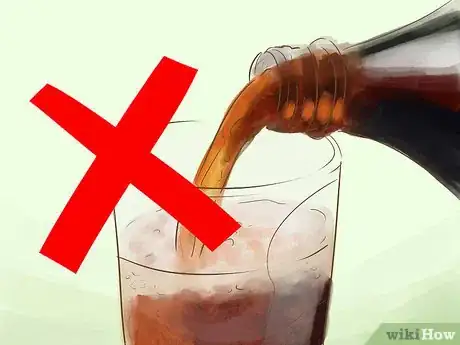
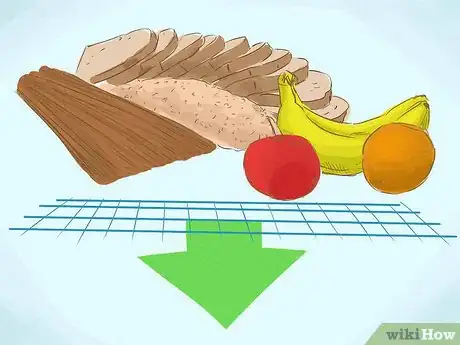
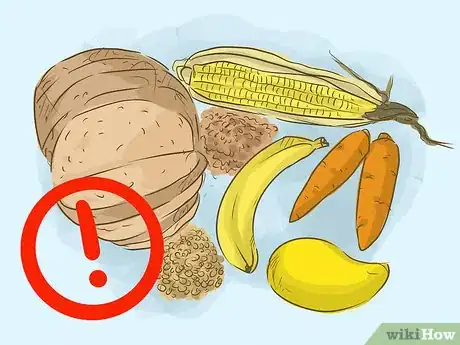
-Step-6.webp)
-Step-3-Version-3.webp)
